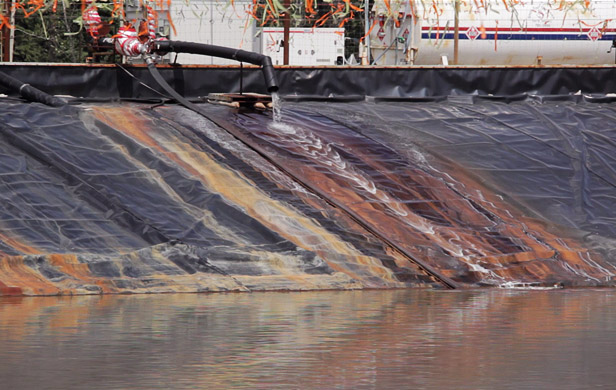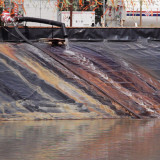
Republished with permission from desmog.ca
Although city officials from Dawson Creek won’t disclose the names of the companies involved, they are confirming that fracking waste has been illegally dumped into the city’s water treatment system on at least two occasions.
Jim Chute, administrative officer for the city, told DeSmog Canada, that illegal dumping has occurred at least three times, but twice the waste was “clearly” related to fracking.
“It has actually been on three occasions in the last 18 months where we’ve caught inappropriate materials being dumped,” he said. “One of those was a load of contaminated diesel. It’s not clear to us exactly how that diesel got contaminated so we don’t know if that was frack-related or not.”
“The other two were a mix of compounds that were clearly flowback waste from a frack operation.”
Chute said the chemicals used in the fracking process can damage the city’s water and sewage treatment facilities which are unable to handle industrial waste. Chute told the Alaska Highway News the waste could cause irreversible damage to living organisms that play a crucial role in the city’s water reclamation system.
Fracking in northeastern B.C.
Fracking, otherwise known as high-volume slickwater hydraulic fracturing, is a controversial extraction process used to free oil and gas from tight rock formations using extremely high pressures and large amounts of toxic chemicals.
The incidents in Dawson Creek involved subcontractors of the gas companies, Chute told DeSmog Canada, saying “virtually all jobs are outsourced to subtrades.”
[quote]If you’re Encana Corporation, you probably don’t drill that well yourself, it’s probably contracted out to a subcontractor like Precision Drilling. And then Precision Drilling themselves don’t build the lease roads, they contract that out to a subcontractor…and they don’t do their own waste disposal, they contract that out.[/quote]
“It’s so busy up here,” Chute said.
“The situations we’ve encountered in every case has been an independent contractor to a company who signs on to a company [saying] they will dispose of the waste in an appropriate manner…and then behave badly, try to save themselves some money by coming to our dump instead of going to the proper spot.”
Chute told the Alaska Highway News the contractors were fined and responsible for cleaning the contaminated holding tanks.
Toxic wastewater a problem for industry
The B.C. Oil and Gas Commission, the provincial oil and gas regulator, is responsible for monitoring the activity of fracking companies, including the disposal of wastewater. B.C. has several private wastewater facilities where recyclable water is separated from toxic waste, which is then disposed of in underground injection wells.
In an emailed statement, B.C. Oil and Gas Commission communications coordinator Hardy Friedrich said, “B.C. has strict regulations related to the disposal of oil and gas waste in the Oil and Gas Waste Regulation and the Hazardous Waste Regulation.”
He added: “Fluids used in hydraulic fracturing must be disposed in a deep underground formation via a service well. Most other waste must be disposed at an approved disposal facility. There are currently 106 operating deep well disposal sites in northeast B.C.”
The difficulty of disposing of wastewater from fracking operations is a problem that has plagued the industry across North America. Flowback fluid from a fracking well includes toxic chemicals and oftentimes radioactive elements from extremely deep wells.
Most municipal wastewater systems are not equipped with the technology to handle such toxic waste in such high volumes.
Dawson Creek, located in the shale gas-rich Montney Basin, has seen a major increase in gas companies in recent years. The Montney Basin, along with the Horn River Basin also in northeastern B.C., could potentially account for 22 per cent of all North American shale gas production by 2020 according to the Canadian Association of Petroleum Producers.
[signoff3]
In the early years of B.C.’s shale gas boom, Grant Shomody, president of Grantech Engineering International, warned of the potential problems producers would face when it comes to wastewater disposal in the Montney:
“If this play develops as producers hope, the number of wells being drilled would severely tax local water resources. In that case, we can expect a lot of ecologically related criticism. There’s also the problem of disposing of the frac water or treating it for reuse. It’s expensive, and Montney producers have not installed water treatment capabilities at their plants.”
A challenge and liability for Dawson Creek
Chute expressed concern with illegal dumping of fracking wastewater, especially in light of new Environment Canada rules, which could hold city officials accountable for negligence.
“Previously there had been less onerous regulations, around how anyone who is a sewage treatment operator or handler of sewage…in order to prevent unauthorized discharge into watercourses,” Chute explained.
These new federal regulations are more strenuous and more robust than any that had been in place in the past, Chute said.
“The onus was put on us to ensure we had the safeguards in place that nothing escaped into the environment. Part and parcel because of that, and [how] thinking changed around Enron and evidence of bad corporate behaviour, part of the regulations imposed personal liability on the people responsible.”
“In Dawson Creek, that would be me,” he said.
Dawson Creek is moving to a new system, said Chute, where a failsafe dump station will monitor regularly for harmful compounds. If those compounds are found, the waste will be prevented from entering the regular treatment system.
Chute says the new facility, which will cost nearly $4 million to build, will be continuously monitored during open hours, 12 hours a day, six days a week.
“All of this is to make sure unauthorized industrial waste doesn’t go into our system.”
“We are going to make sure that we catch anybody that tries to circumvent the system by coming to us because we’re a shorter haul than they’d have to go to the proper spot.”


This makes me feel angry! Do these people really have a heart? aren’t there supposed to be watchers taking care of this place? Many lives will be affected by this. Do these people even care? This is really annoying!
Wow, look at them dumping frac fluid in that engineered pond…..with sample wells??? All sampled on a schedule, as mandated by government. Accidents happen, people try to save money. No different when your neighbour dumps his can of used oil, coolant, toilet bowl cleaner. I seen these people out taking pictures. It was hot out and heck why would we shut off our car??? keep that A/C cranked, it’s to bad they misinform general public. If your involved, understand what is in place to protect everyone.
If the city knows this is happening then why isnt there cameras or security on site to monitor every load that comes in, it may cost some bucks but the end result would be more cost effective if there is a chance of having a impact on the water and sewer system and having to replace them.
A camera ?
Trucks dumping water arriving hourly. Which water is the toxic water……….? Cant tell that from a camera.
This is very disturbing especially for someone that lives there. In another note it’s not Dawson’s Creek that was a show about a kid named Dawson. Our town is Dawson Creek. If you could see to changing that please.
Agreed, it is disturbing, Kathy.
Apologies – the town’s name was misspelled once out of 7 occasions in the piece, but that has now been corrected. Thank you for catching that.
Im also curious as to what the percentage of waste water is retrieved from drill sites?
It should be a simple calculation of water pumped in the well minus a percentage of water lost in the drilling/fracking process and then water sucked out of the well.
The water losses would vary depending upon the porosity of the rock but after drilling hundreds or thousands of wells and average loss could be calculated.
Then every well could be audited for water in vs water out. And the water out would have to be accounted for in deliveries to either waste treatment plants or deep injection sites.
Seems like the Provincial Environmental govt inspectors should be able to figure someing like this out.
But then again, we are talking aboult govt employees that typically arent paid to think.
Hmmmmm, If several “unnamed companies” feel comfortable enough to illegally dump fracking waste water into the water treatment plant it begs the question.
What and where are other companies dumping waste water?
I’m also disturbed at the fact that “deep well injection sites” are an alternative to waste treatment plants.
That contaminated water will eventually work its way to the surface and if you dont believe me try visiting any of the hundreds of hotsprings in BC where water has naturally draining into the ground, heated up and worked its way back to the surface.
I cant wait for the excuses of politicians of the future when entire villages, towns, and cities are rendered uninhabitable because the drinking water is toxic and its too expensive to truck potable water in for the locals. Its alredy happened on farms in Alberta.
But, of course the politicians of the furture will just blame the politicians of the past and wash their hands of all blame……..
Greed, stupidity and arrogance, pure and simple.
Pass a Law today making anyone involved personally, financially and criminally liable for future environmental degradation for future problems.
Oh wait! We already have a law like that. But it only holds the land owner culpable, not the lying, schemeing politician that allowed it to happen.
Time for a major rethink on political reponsibility for future descisions.
like THAT will ever happen.